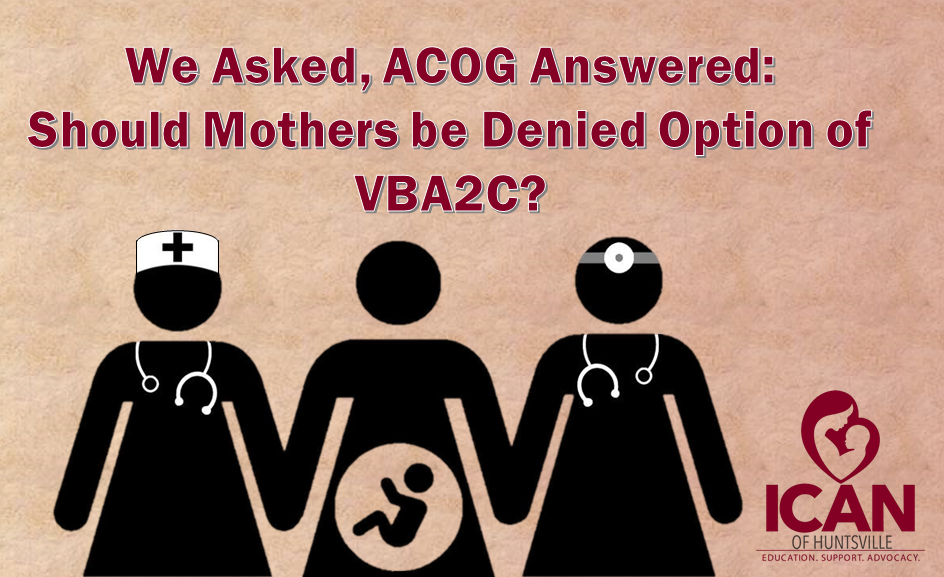Should Mothers be Denied Option of VBA2C? ACOG clarifies

*For privacy reasons, certain names and personal information have been removed.
If you have ever wondered what the leadership of your local ICAN chapter does, the following is a good example of our work to promote ICAN’s mission of improving maternal-child health by reducing unnecessary cesareans through education, providing support for cesarean recovery, and advocating for vaginal birth after cesarean (VBAC).
In September, a member of the ICAN of Huntsville leadership team encountered two situations within our local community about Trial of Labor after Cesarean (TOLAC) access that she felt needed additional clarification. On behalf of ICAN of Huntsville, Justen contacted the American Congress of Obstetricians and Gynecologists (ACOG). The original email included two questions, regarding two separate, but extremely important issues. In the following paragraphs, we will share our question, and also ACOG’s response. At a later date, we will be sharing the other question, along with ACOG’s response.
One of the questions posed to ACOG involved a local OB/GYN office that had interpreted ACOG’s Practice Bulletin 115 in a way that did not favor offering women access to a trial of labor after two cesareans. The wording of this Practice Bulletin is written in a way that could be confusing for some. The following email was sent to ACOG regarding clarification on a woman’s access to a trial of labor after two cesareans:
Dear ACOG Medical Library,
My name is Justen Alexander, and I spoke with one of the Medical Librarians this afternoon. This email is in regards to an ICAN of Huntsville chapter member … (this part will be discussed in Part 2 of our blog).
We would also like to have clarification on the wording of these two sentences from PB 115 regarding access to VBAC and VBA2C:
1. “Given the overall data, it is reasonable to consider women with two previous low transverse cesarean deliveries to be candidates for TOLAC, and to counsel them based on the combination of other factors that affect their probability of achieving a successful VBAC.”
2. “Most women with one previous cesarean delivery with a low-transverse incision are candidates for and should be counseled about VBAC and offered TOLAC. “
In #1, the phrase “reasonable to consider” is used, and in #2, “most”, “are candidates”, and “should be counseled” are used. The office in question, is using the difference in terminology to say ACOG only recommends physicians “consider” counseling women on VBA2C, but that they don’t have to mention it at all, since it says “consider”, vs “should be counseled”. What is the true meaning of the difference in terminology in these sentences? Should all women, with one or two low transverse incisions, be counseled on the benefits and risks of VBAC or VBA2C?
We would appreciate clarification on these issues, as the new policy for the office in question is going to affect many women in our community, and cause an even greater lack of access to care, especially for women of Non-White ethnicity, and VBA2C patients. Thank you for your help!
Sincerely,
ICAN of Huntsville Leadership Team
The difference in wording between the recommendations for VBAC and VBA2C, could be interpreted by some as the practice bulletin saying the physician should only “consider” offering a trial of labor to women that have had two prior cesareans. The issue here was surrounding the usage of “consider” for TOLA2C, versus “should be” for TOLAC. We received a formal response on December 5th, following a discussion at the ACOG Practice Bulletin Committee meeting in November. Here is their response:
We reviewed your email at the November committee meeting. The committee members were very engaged in the conversation.
The Practice Bulletin was written to describe clinical and other characteristics associated with a vaginal birth among those undergoing a trial of labor. The intention was not to create confusion among practices regarding TOLAC or TOLA2C. The Practice Bulletin was crafted so that patients and physicians can have an informed and shared conversation about delivery plans. Most women with two previous low-transverse cesarean deliveries are candidates for and should be offered TOLAC and counseled based on the combination of individual factors that affect their risk and probability of achieving a successful VBAC.
Although we cannot do anything to change the language of this published document right now, we will definitely consider your email in any possible future revision of the Practice Bulletin.
American College of Obstetricians and Gynecologists
Per the above email sent to ICAN of Huntsville from ACOG staff, ACOG has clarified the wording in Practice Bulletin 115 for us by saying “most women with two previous low-transverse cesarean deliveries are candidates for and should be offered” a trial of labor and counseled appropriately on their individual potential risks. In short, for most women, after two previous low-transverse cesarean deliveries, access to delivery mode options should be no different than those women with one prior low-transverse cesarean delivery. We are so thankful to ACOG for clarifying this extremely important matter for our community. We are especially grateful that the practice bulletin committee members were engaged in the conversation and that they appreciated the seriousness of this issue. We are hopeful that the clarification the Practice Bulletin Committee has provided will increase access to evidence based care, open dialogue, and shared decision making between care providers and patients. We are including Practice Bulletin 115 here: acog-vbac
ICAN of Huntsville Leadership Team
Please click the following links for more information from ACOG on VBAC:
You can contact ACOG at: Practice@acog.org if you have any questions or concerns regarding a trial of labor after cesarean.
Posted in Advocacy, VBAC, VBAmC | Tagged: Alabama Birth Coalition, birth statistics alabama, cesarean section, Huntsville Alabama VBAC, TOLA2C, TOLAC, vba2c, VBAC, vbac alabama, VBAC care provider

